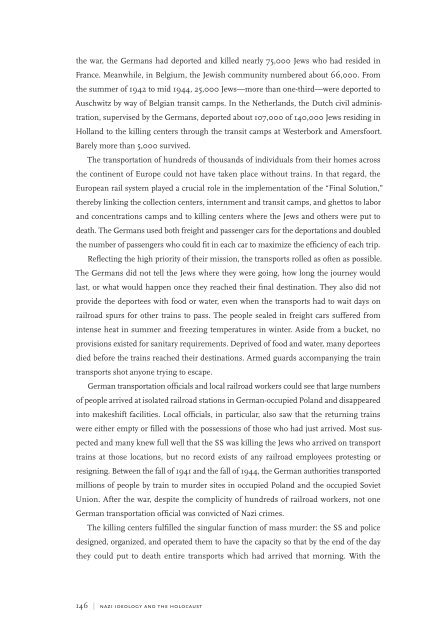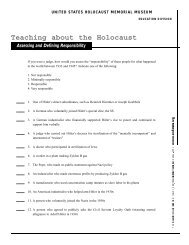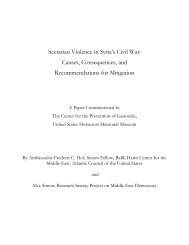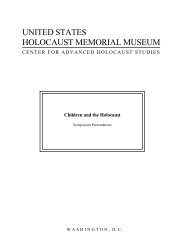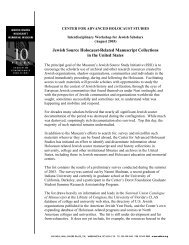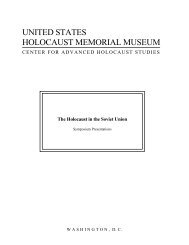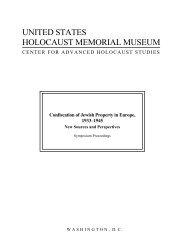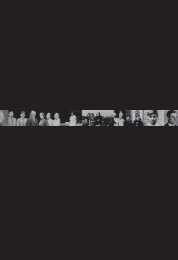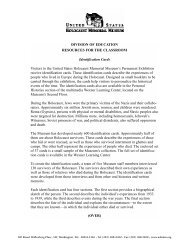the quest for racial purity - United States Holocaust Memorial Museum
the quest for racial purity - United States Holocaust Memorial Museum
the quest for racial purity - United States Holocaust Memorial Museum
You also want an ePaper? Increase the reach of your titles
YUMPU automatically turns print PDFs into web optimized ePapers that Google loves.
<strong>the</strong> war, <strong>the</strong> Germans had deported and killed nearly 75,000 Jews who had resided in<br />
France. Meanwhile, in Belgium, <strong>the</strong> Jewish community numbered about 66,000. From<br />
<strong>the</strong> summer of 1942 to mid 1944, 25,000 Jews—more than one-third—were deported to<br />
Auschwitz by way of Belgian transit camps. In <strong>the</strong> Ne<strong>the</strong>rlands, <strong>the</strong> Dutch civil adminis-<br />
tration, supervised by <strong>the</strong> Germans, deported about 107,000 of 140,000 Jews residing in<br />
Holland to <strong>the</strong> killing centers through <strong>the</strong> transit camps at Westerbork and Amersfoort.<br />
Barely more than 5,000 survived.<br />
The transportation of hundreds of thousands of individuals from <strong>the</strong>ir homes across<br />
<strong>the</strong> continent of Europe could not have taken place without trains. In that regard, <strong>the</strong><br />
European rail system played a crucial role in <strong>the</strong> implementation of <strong>the</strong> “Final Solution,”<br />
<strong>the</strong>reby linking <strong>the</strong> collection centers, internment and transit camps, and ghettos to labor<br />
and concentrations camps and to killing centers where <strong>the</strong> Jews and o<strong>the</strong>rs were put to<br />
death. The Germans used both freight and passenger cars <strong>for</strong> <strong>the</strong> deportations and doubled<br />
<strong>the</strong> number of passengers who could fit in each car to maximize <strong>the</strong> efficiency of each trip.<br />
Reflecting <strong>the</strong> high priority of <strong>the</strong>ir mission, <strong>the</strong> transports rolled as often as possible.<br />
The Germans did not tell <strong>the</strong> Jews where <strong>the</strong>y were going, how long <strong>the</strong> journey would<br />
last, or what would happen once <strong>the</strong>y reached <strong>the</strong>ir final destination. They also did not<br />
provide <strong>the</strong> deportees with food or water, even when <strong>the</strong> transports had to wait days on<br />
railroad spurs <strong>for</strong> o<strong>the</strong>r trains to pass. The people sealed in freight cars suffered from<br />
intense heat in summer and freezing temperatures in winter. Aside from a bucket, no<br />
provisions existed <strong>for</strong> sanitary requirements. Deprived of food and water, many deportees<br />
died be<strong>for</strong>e <strong>the</strong> trains reached <strong>the</strong>ir destinations. Armed guards accompanying <strong>the</strong> train<br />
transports shot anyone trying to escape.<br />
German transportation officials and local railroad workers could see that large numbers<br />
of people arrived at isolated railroad stations in German-occupied Poland and disappeared<br />
into makeshift facilities. Local officials, in particular, also saw that <strong>the</strong> returning trains<br />
were ei<strong>the</strong>r empty or filled with <strong>the</strong> possessions of those who had just arrived. Most suspected<br />
and many knew full well that <strong>the</strong> SS was killing <strong>the</strong> Jews who arrived on transport<br />
trains at those locations, but no record exists of any railroad employees protesting or<br />
resigning. Between <strong>the</strong> fall of 1941 and <strong>the</strong> fall of 1944, <strong>the</strong> German authorities transported<br />
millions of people by train to murder sites in occupied Poland and <strong>the</strong> occupied Soviet<br />
Union. After <strong>the</strong> war, despite <strong>the</strong> complicity of hundreds of railroad workers, not one<br />
German transportation official was convicted of Nazi crimes.<br />
The killing centers fulfilled <strong>the</strong> singular function of mass murder: <strong>the</strong> SS and police<br />
designed, organized, and operated <strong>the</strong>m to have <strong>the</strong> capacity so that by <strong>the</strong> end of <strong>the</strong> day<br />
<strong>the</strong>y could put to death entire transports which had arrived that morning. With <strong>the</strong><br />
146 | nazi ideology and <strong>the</strong> holocaust


